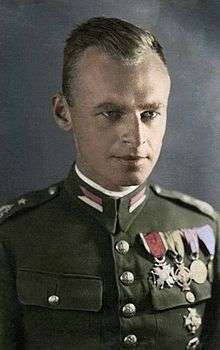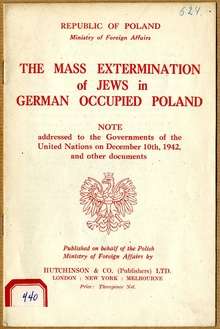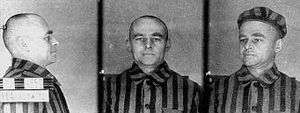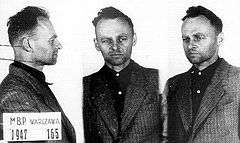Witold Pilecki
| Witold Pilecki | |
|---|---|
 Pilecki in a colorized pre-1939 photo | |
| Born |
13 May 1901 Olonets, Russian Empire |
| Died |
25 May 1948 (aged 47) Warsaw, Poland |
| Allegiance | Second Polish Republic |
| Years of service | 1918 - 1947 |
| Rank | Captain, Cavalry master |
| Commands held | Commander of Secret Polish Army (1939) |
| Battles/wars | Battle of Warsaw, Kiev Offensive (1920) |
| Awards |
|
Witold Pilecki (13 May 1901 – 25 May 1948; Polish pronunciation: [ˈvitɔlt piˈlɛt͡skʲi]; codenames Roman Jezierski, Tomasz Serafiński, Druh, Witold) was a Polish soldier, a rittmeister of the Polish Cavalry during the Second Polish Republic, the founder of the Secret Polish Army (Tajna Armia Polska) resistance group in German-occupied Poland in November 1939, and a member of the underground Home Army (Armia Krajowa), which was formed in February 1942. He was the author of Witold's Report, the first comprehensive Allied intelligence report on Auschwitz concentration camp and the Holocaust. He was Roman Catholic.[1]
During World War II, he volunteered for a Polish resistance operation to get imprisoned in the Auschwitz death camp in order to gather intelligence and escape. While in the camp, Pilecki organized a resistance movement and as early as 1941, informed the Western Allies of Nazi Germany's Auschwitz atrocities. He escaped from the camp in 1943 after nearly two and a half years of imprisonment. Pilecki took part in the Warsaw Uprising[2] in August 1944.[3] He remained loyal to the London-based Polish government-in-exile after the Soviet-backed communist takeover of Poland and was arrested in 1947 by the Stalinist secret police (Urząd Bezpieczeństwa) on charges of working for "foreign imperialism", thought to be a euphemism for MI6.[4] He was executed after a show trial in 1948. Until 1989, information about his exploits and fate was suppressed by the Polish communist regime.[4][5]
As a result of his efforts, he is considered as "one of the greatest wartime heroes".[3][6][7] In the foreword to the book The Auschwitz Volunteer: Beyond Bravery[8] Michael Schudrich, the Chief Rabbi of Poland, wrote as follows: "When God created the human being, God had in mind that we should all be like Captain Witold Pilecki, of blessed memory."[1] In the introduction to that book Norman Davies, a British historian, wrote: "If there was an Allied hero who deserved to be remembered and celebrated, this was a person with few peers."[1] At the commemoration event of International Holocaust Remembrance Day held in the US Holocaust Memorial Museum on 27 January 2013 Ryszard Schnepf, the Polish Ambassador to the US, described Pilecki as a "diamond among Poland's heroes" and "the highest example of Polish patriotism".[7][9]
Life
Pilecki was born in Olonets, Karelia, where his family had been forcibly resettled by Imperial Russian authorities after the suppression of Poland's January Uprising of 1863–64.[10] His grandfather, Józef Pilecki, had spent seven years in exile in Siberia for his part in the rising. In 1910, Pilecki moved with his family to Wilno (Vilnius, Lithuania), where he completed Commercial School and joined the secret ZHP Scouts organization.[10] In 1916, he moved to Orel, Russia, where he founded a local ZHP group.[10]
During World War I, in 1918, Pilecki joined a ZHP Scout section of the Polish self-defense units under General Władysław Wejtko in the Wilno area.[10] When his sector of the front was overrun by the Bolsheviks, his unit for a time conducted partisan warfare behind enemy lines. Pilecki then joined the regular Polish Army and took part in the Polish-Soviet War of 1919–1920, serving under Capt. Jerzy Dąbrowski.[10] He fought in the Kiev Offensive (1920) as part of a cavalry unit defending Grodno (in present-day Belarus). On 5 August 1920, he joined the 211th Uhlan Regiment and fought in the crucial Battle of Warsaw and at Rudniki Forest (Puszcza Rudnicka) and took part in the liberation of Wilno.[10] He was twice awarded the Krzyż Walecznych (Cross of Valor) for gallantry.[11]
After the Polish-Soviet War ended in 1921 with the Peace of Riga, Pilecki passed his high-school graduation exams (matura) in Wilno and passed the exams for a non-commissioned officer position in the Polish Army.[10] He also studied at the Stefan Batory University in Wilno and rebuilt his family estate, ruined during the war.[10] He then took officer training courses.[10] He was assigned to a cavalry regiment in 1926 as ensign, or the second lieutenant of the reserves. While in the reserves, he actively supported local paramilitary training activities.[10] In the interbellum, he worked on his family's farm in the village of Sukurcze and was known as a social work activist and an amateur painter.[10] On 7 April 1931, he married Maria Pilecka (1906 – 6 February 2002), née Ostrowska. They had two children, born in Wilno: Andrzej (16 January 1932) and Zofia (14 March 1933). In 1938, he received the Silver Cross of Merit for his involvement in the community and social work.[10]
World War II
| Part of a series on the |
Underground State |
|---|
 |
|
Authorities |
|
Political organizations |
|
Military organizations |
|
Related topics |
Shortly before the outbreak of World War II, on 26 August 1939, Pilecki was mobilized as a cavalry platoon commander. He was assigned to the 19th Infantry Division under Józef Kwaciszewski, part of the Polish Army Prusy.[10] His unit took part in heavy fighting against the advancing Germans during the invasion of Poland and was partially destroyed.[10] Pilecki's platoon withdrew to the southeast, toward Lwów (now L'viv, in Ukraine) and the Romanian bridgehead, and was incorporated into the recently formed 41st Infantry Division, in which he served as divisional second-in-command under Major Jan Włodarkiewicz.[10] Pilecki and his men destroyed seven German tanks, shot down one aircraft, and destroyed two more on the ground.[12][13] On 17 September, the Soviet Union invaded eastern Poland pursuant to the Molotov-Ribbentrop Pact. Involved in more heavy fighting on two fronts, Pilecki's division was disbanded by 22 September, parts of it surrendering to their enemies.[10] Pilecki returned to Warsaw with his commander, Major Włodarkiewicz.[10]
On 9 November 1939, the two men founded the Secret Polish Army (Tajna Armia Polska, TAP), one of the first underground organizations in Poland.[10][14] Pilecki became organizational commander of TAP as it expanded to cover not only Warsaw, but Siedlce, Radom, Lublin, and other major cities of central Poland.[10] By 1940, TAP had approximately 8,000 men (more than half of them armed), some 20 machine guns and several anti-tank rifles. Later, the organization was incorporated into the Union for Armed Struggle (Związek Walki Zbrojnej), later renamed and better known as the Home Army (Armia Krajowa, or AK).[10][15] Within the AK, TAP elements became the core of the Wachlarz unit.[11]
Auschwitz

In 1940, Pilecki presented to his superiors a plan to enter Germany's Auschwitz concentration camp at Oświęcim (the Polish name of the locality), gather intelligence on the camp from the inside and organize inmate resistance.[14] Until then, little had been known about how the Germans ran the camp, and it was thought to be an internment camp or large prison rather than a death camp. His superiors approved the plan and provided him with a false identity card in the name of "Tomasz Serafiński".[16] On September 19, 1940, he deliberately went out during a Warsaw street roundup (łapanka) and was caught by the Germans, along with some 2,000 civilians (among them, Władysław Bartoszewski).[16] After two days of detention in the Light Horse Guards Barracks, where prisoners suffered beatings with rubber truncheons,[17] Pilecki was sent to Auschwitz and was assigned inmate number 4859.[16]

At Auschwitz, while working in various kommandos and surviving pneumonia, Pilecki organized an underground Union of Military Organizations (Związek Organizacji Wojskowej, ZOW).[10][18] Many smaller underground organizations at Auschwitz eventually merged with ZOW.[10][19] ZOW's tasks were to improve inmate morale, provide news from outside, distribute extra food and clothing to members, set up intelligence networks and train detachments to take over the camp in the event of a relief attack by the Home Army, arms airdrops or an airborne landing by the Polish 1st Independent Parachute Brigade based in Britain.[10][18]
ZOW provided the Polish underground with invaluable information about the camp.[18] From October 1940, ZOW sent reports to Warsaw,[20] and beginning in March 1941, Pilecki's reports were being forwarded via the Polish resistance to the British government in London.[21] In 1942, Pilecki's resistance movement was also broadcasting details on the number of arrivals and deaths in the camp and the inmates' conditions using a radio transmitter that was built by camp inmates. The secret radio station, built over seven months using smuggled parts, was broadcasting from the camp until the autumn of 1942, when it was dismantled by Pilecki's men after concerns that the Germans might discover its location because of "one of our fellow's big mouth".[17]
These reports were a principal source of intelligence on Auschwitz for the Western Allies. Pilecki hoped that either the Allies would drop arms or troops into the camp or that the Home Army would organize an assault on it from outside. Such plans, however, were all judged impossible to carry out.[10][19] Meanwhile, the Gestapo redoubled its efforts to ferret out ZOW members, succeeding in killing many of them.[10][22] Pilecki decided to break out of the camp with the hope of convincing Home Army leaders personally that a rescue attempt was a valid option. When he was assigned to a night shift at a camp bakery outside the fence, he and two comrades overpowered a guard, cut the phone line and escaped on the night of 26/27 April 1943, taking with them documents stolen from the Germans.[23]
Outside the camp
After several days, Pilecki made contact with Home Army units.[10][19] On 25 August 1943, Pilecki reached Warsaw and joined the Home Army's intelligence department. The Home Army, after losing several operatives in reconnoitering the vicinity of the camp, including the Cichociemny Stefan Jasieński, decided that it lacked sufficient strength to capture the camp without Allied help. Pilecki's detailed report (Raport Witolda – Witold's Report) estimated that "By March 1943 the number [of people gassed on arrival] reached 1.5 million.".[24]
The Home Army decided that it did not have enough force to storm the camp by itself.[18] In 1944, the Russian army, despite being within attacking distance of the camp, showed no interest in a joint effort with the Home Army and the ZOW to free it.[25] Until he became involved in the Warsaw Uprising, Pilecki remained in charge of coordinated ZOW and AK activities and provided what limited support he was able to offer to ZOW.[10]
On 23 February 1944, Pilecki was promoted to cavalry captain (rotmistrz) and joined a secret anti-communist organization, NIE (in Polish: "NO or NIEpodległość – INdependence"), formed as a secret organization within the Home Army with the goal of preparing resistance against a possible Soviet occupation.[10]
Warsaw Uprising
When the Warsaw Uprising broke out on 1 August 1944, Pilecki volunteered for the Kedyw's Chrobry II group and fought in "Mazur" platoon, 1st company "Warszawianka" of the National Armed Forces. At first, he fought in the northern city center as a simple private, without revealing his actual rank.[10] Later, as many officers fell, he disclosed his true identity and accepted command.[10] His forces held a fortified area called the "Great Bastion of Warsaw". It was one of the most outlying partisan redoubts and caused considerable difficulties for German supply lines. The bastion held for two weeks in the face of constant attacks by German infantry and armor. On the capitulation of the uprising, Pilecki hid some weapons in a private apartment and went into captivity. He spent the rest of the war in German prisoner-of-war camps at Łambinowice and Murnau.[10]
Communist Poland

On 9 July 1945, Pilecki was liberated and soon afterwards joined the 2nd Polish Corps, which was stationed in Italy, where he wrote a monograph on Auschwitz.[10] As relations between Poland's London based wartime government-in-exile and the Soviet-backed Polish Committee of National Liberation worsened, in September 1945, Pilecki accepted orders from General Władysław Anders, commander of the 2nd Polish Corps to return to Poland under a false identity and gather intelligence to be sent to the government-in-exile.[10][19]
Pilecki returned to Poland in October 1945, where he proceeded to organize his intelligence network.[4][10] In early 1946, the Polish government-in-exile decided that the post-war political situation afforded no hope of Poland's liberation and ordered the remaining active members of the Polish resistance (who became known as the cursed soldiers) to either return to their normal civilian lives or escape to the West. In July 1946, Pilecki was informed that his cover was blown and ordered to leave; but he declined.[10] In April 1947, he began collecting evidence of Soviet atrocities in Poland as well as the arrest and prosecution of former members of the Home Army and Polish Armed Forces in the West, which often resulted in execution or imprisonment.[11]
Arrest and execution


On 8 May 1947, he was arrested by the Ministry of Public Security.[10] Prior to trial, he was repeatedly tortured. The investigation of Pilecki's activities was supervised by Colonel Roman Romkowski. He was interrogated by Col. Józef Różański, and lieutenants S. Łyszkowski, W. Krawczyński, J. Kroszel, T. Słowianek, Eugeniusz Chimczak and S. Alaborski – men who were especially infamous for their savagery. But Pilecki sought to protect other prisoners and revealed no sensitive information.[10]
On 3 March 1948, a show trial took place.[26] Testimony against Pilecki was presented by a future Polish prime minister, Józef Cyrankiewicz, himself an Auschwitz survivor. Pilecki was accused of illegal border crossing, use of forged documents, not enlisting with the military, carrying illegal arms, espionage for General Władysław Anders, espionage for "foreign imperialism" (thought to be British intelligence)[4] and planning to assassinate several officials of the Ministry of Public Security of Poland. Pilecki denied the assassination charges, as well as espionage, although he admitted to passing information to the 2nd Polish Corps, of which he considered himself an officer and thus claimed that he was not breaking any laws. He pleaded guilty to the other charges. On 15 May, with three of his comrades, he was sentenced to death. Ten days later, on 25 May 1948, Pilecki was executed at the Mokotów Prison in Warsaw (also known as Rakowiecka Prison),[5] by Staff Sergeant Piotr Śmietański (who was nicknamed "The Butcher of Mokotow Prison" by the inmates).[27]
I've been trying to live my life so that in the hour of my death I would rather feel joy, than fear.— After the announcement of the death sentence, Bartłomiej Kuraś, Witold Pilecki – w Auschwitzu z własnej woli, „Ale Historia”, w: „Gazeta Wyborcza”, 22 kwietnia 2013.
During Pilecki's last conversation with his wife he told her: "I cannot live. They killed me. Because Oświęcim [Auschwitz] compared with them was just a trifle." His final words before his execution were "Long live free Poland".
Pilecki's place of burial has never been found but is thought to be somewhere within Warsaw's Powązki Cemetery.[10][28] After the fall of communism in Poland a symbolic gravestone was erected in his memory at Ostrowa Mazowiecka Cemetery. In 2012, Powązki Cemetery was partially excavated in an effort to find Pilecki's remains.[29]
Legacy
Pilecki's show trial and execution was part of a wider campaign of repression against former Home Army members and others connected with the Polish Government-in-Exile in London. In 2003, the prosecutor, Czesław Łapiński, and several others involved in the trial were charged with complicity in Pilecki's murder. Józef Cyrankiewicz, the chief prosecution witness, was already dead, and Łapiński died in 2004, before the trial was concluded.[11]
_(19122651385).jpg)
Witold Pilecki and all others sentenced in the show trial were rehabilitated on 1 October 1990.[11] In 1995, he was posthumously awarded the Order of Polonia Restituta and in 2006 he received the Order of the White Eagle, the highest Polish decoration.[10][28] On 6 September 2013, he was posthumously promoted by the Minister of National Defence to the rank of Colonel.[30]
Films about Pilecki include a made-for-TV movie, Śmierć rotmistrza Pileckiego (The Death of Captain Pilecki), starring Polish actor Marek Probosz;[31] and the documentaries Against the Odds: Resistance in Nazi Concentration Camps;[32] and Heroes of War: Poland produced by Sky Vision for the History Channel UK.[33] A number of books have been written about Pilecki. In addition, Pilecki's comprehensive 1945 report on his undercover mission at Auschwitz was published in English for the first time in 2012, under the title The Auschwitz Volunteer: Beyond Bravery, and was hailed by The New York Times as "a historical document of the greatest importance."[3]
Polish Army career summary
- Second Lieutenant (podporucznik) from 1926
- First Lieutenant (porucznik) from 11 November 1941 (promoted while at Auschwitz)
- Captain (cavalry rotmistrz) from 11 November 1943
- Colonel (pułkownik) from 6 September 2013 (posthumously).
Awards, decorations and citations
- Knight of the Order of the White Eagle (posthumously, 2007)
- Commander's Cross of the Order of Polonia Restituta – (posthumously, 1995)
- Cross of Valour, awarded twice
- Silver Cross of Merit (1938)
- Army of Central Lithuania Cross of Merit
- War Medal 1918–1921
- Decade of Independence Regained
- Auschwitz Cross
- Warsaw Uprising Cross
- Order of the Star of Perseverance (posthumously)
See also
- History of Poland (1939–45)
- Polish contribution to World War II
- Jan Karski
- Vrba-Wetzler report
- Western betrayal
- Soviet repressions of Polish citizens (1939–46)
- Anti-communist resistance in Poland (1944–46)
- 1951 Mokotów Prison execution
- Emil August Fieldorf
- Łukasz Ciepliński
- Heroes (Sabaton album), where the song "Inmate 4859" tells Captain Pilecki's story
References
- 1 2 3 The Book Heaven, The man who volunteered for Auschwitz: the greatest story never told, Stanford University. Posted on 10 June 2012.
- ↑ For a detailed history of the Warsaw uprising, and the role of Witold Pilecki (known as "Captain Roman"), see Norman Davies, Rising '44. "The Battle for Warsaw" (London: Pan Books, 2004).
- 1 2 3 Snyder, Timothy (22 June 2012) Were We All People?, The New York Times.
- 1 2 3 4 Tchorek 2009
- 1 2 Piekarski 1990, p. 249
- ↑ Remembering Unsung Heroes Of The Holocaust, The Jewish Week. Published on 1 February 2013.
- 1 2 Auschwitz inmate Pilecki – 'diamond among heroes', Thenews.pl (Polish Radio English Section). Published on 28 January 2013.
- ↑ The Auschwitz volunteer: about the book, Aquila Polonica Publishing, Los Angeles.
- ↑ Captain Witold Pilecki commemorated at the U.S. Holocaust Memorial Museum in Washington, DC, Embassy of the Republic of Poland in Washington, DC.
- 1 2 3 4 5 6 7 8 9 10 11 12 13 14 15 16 17 18 19 20 21 22 23 24 25 26 27 28 29 30 31 32 33 34 35 36 37 38 39 Świerczek, Lidia. Pilecki's life. Institute of National Remembrance. Last accessed on 14 March 2009.
- 1 2 3 4 5 (Polish) Detailed biography of Witold Pilecki on Whatfor at the Wayback Machine (archived 15 January 2008). Last accessed on 21 November 2007.
- ↑ Beadle, Jeremy and Harrison, Ian (2008) Firsts, lasts & onlys: military. Anova Books. ISBN 1-905798-06-7. p. 129
- ↑ Wysocki, Wiesław Jan (1994) Rotmistrz Pilecki. "Gryf". ISBN 83-85521-23-2. p.32
- 1 2 Lewis 1999, p. 389
- ↑ Lukas, Richard C. (1989) Out of the inferno: Poles remember the Holocaust. University Press of Kentucky. ISBN 0-8131-1692-9. p. 5
- 1 2 3 Lewis 1999, p. 390
- 1 2 Pilecki, Witold (2012). The Auschwitz Volunteer: Beyond Bravery. USA: Aquila Polonica (US) Ltd. p. 460. ISBN 978-1-60772-010-2.
- 1 2 3 4 Wyman 1976, p. 1168
- 1 2 3 4 Foot 2003, pp. 117–126
- ↑ Lewis 1999, p. 393
- ↑ Lewis 1999, p. 394
- ↑ Garlinski, Jozef (1975) Fighting Auschwitz: the Resistance Movement in the Concentration Camp. Fawcett. ISBN 0-904014-09-6. pp. 191–197
- ↑ Lewis 1999, p. 399
- ↑ "Raport"W"". polandpolska.org. Retrieved 2 February 2016.
- ↑ Wyman 1976, p. 1169
- ↑ The Times, 1948
- ↑ Płużański, Tadeusz M. "Strzał w tył głowy." Publicystyka Antysocjalistycznego Mazowsza.
- 1 2 (Polish) "60 lat temu zginął rotmistrz Witold Pilecki" (Sixty years ago Captain Witold Pilecki died) Gazeta Wyborcza, PAP, 23 May 2008
- ↑ Puhl, Jan. (9 August 2012) Poland Searches for Remains of World War II Hero Witold Pilecki. Spiegel.de. Retrieved on 2015-09-19.
- ↑ "MON awansował Witolda Pileckiego" (in Polish). RMF FM/PAP. 6 September 2013. Retrieved 10 October 2013.
- ↑ Śmierć Rotmistrza Pileckiego. FilmPolski.pl. Retrieved on 19 September 2015.
- ↑ Against The Odds. Capital j. Films. Retrieved on 19 September 2015.
- ↑ History UK orders "Heroes of War" from Sky Vision. Realscreen (25 April 2013). Retrieved on 2015-09-19.
Bibliography
- Foot, Michael Richard Daniell (2003), Six Faces of Courage. Secret agents against Nazi tyranny. Witold Pilecki, Leo Cooper, ISBN 0-413-39430-1
- Davies, Norman, Rising '44. "The Battle for Warsaw" (London: Pan Books, 2004),ISBN 0-333-90568-7 .
- Lewis, Jon E. (1999), The Mammoth Book of True War Stories, Carroll & Graf Publishers, ISBN 0-7867-0629-5
- Piekarski, Konstanty R. (1990), Escaping Hell: The Story of a Polish Underground Officer in Auschwitz and Buchenwald, Dundurn Press Ltd., ISBN 1-55002-071-4
- Staff correspondent (5 March 1948), "Polish Left-Wing Relations: No Fusion as Yet", The Times, London, p. 3, retrieved 12 March 2009
- Tchorek, Kamil (12 March 2009), "Double life of Witold Pilecki, the Auschwitz volunteer who uncovered Holocaust secrets", The Times, London, retrieved 16 March 2009
- Wyman, David S. (December 1976), "Review: Jozef Garlinski. Fighting Auschwitz: The Resistance Movement in the Concentration Camp", American Historical Review, American Historical Association, 81 (5), pp. 1168–1169, doi:10.2307/1853043, ISSN 0002-8762, JSTOR 1853043
Further reading
- Ciesielski E. Wspomnienia Oświęcimskie [Auschwitz Memoirs]. Kraków: 1968.
- Cyra, Adam. Ochotnik do Auschwitz – Witold Pilecki 1901–1948 [Volunteer for Auschwitz]. Oświęcim: 2000. ISBN 83-912000-3-5
- Cyra, Adam. Spadochroniarz Urban [Urban Paratrooper]. Oświęcim: 2005.
- Cyra, Adam and Wiesław Jan Wysocki. Rotmistrz Witold Pilecki. Oficyna Wydawnicza VOLUMEN, 1997. ISBN 83-86857-27-7
- Garlinski, Jozef. Fighting Auschwitz: the Resistance Movement in the Concentration Camp. Fawcett, 1975. ISBN 0-449-22599-2 reprinted by Time Life Education, 1993. ISBN 0-8094-8925-2 (see also review in The Times)
- Gawron, W. Ochotnik do Oświęcimia [Volunteer for Auschwitz]. Calvarianum: Auschwitz Museum, 1992.
- Patricelli, M. Il volontario [The Volunteer]. Laterza 2010. ISBN 88-420-9188-X
- Piekarski, Kon. Escaping Hell: The Story of a Polish Underground Officer in Auschwitz and Buchenwald. Dundurn Press, 1989. ISBN 1-55002-071-4, ISBN 978-1-55002-071-7
- Pilecki, W. (Translated by Jarek Garlinski) The Auschwitz Volunteer: Beyond Bravery. Aquila Polonica, 2012. ISBN 978-1-60772-010-2, ISBN 978-1-60772-009-6
- Wysocki, Wiesław Jan. Rotmistrz Pilecki. Pomost, 1994. ISBN 83-85209-42-5
External links
| Wikiquote has quotations related to: Witold Pilecki |
- Tablet Magazine essay Vladislav Davidzon
- Meet The Man Who Sneaked Into Auschwitz.
- The Man Who Volunteered for Auschwitz
- Witold Pilecki's report from Auschwitz in English
- Witold Pilecki's report from Auschwitz in Polish (Polish)
- Additional reports of Pilecki (Polish)
- Andrzej M. Kobos, Witold Pilecki w Piekle XX Wieku, Zwoje 5 (9), 1998 (Polish)
- Józef Garlinski, The Polish Underground Movement in Auschwitz Concentration Camp
- The Murder of Cavalry Captain Witold Pilecki
- IMDB Page for film Operation Auschwitz